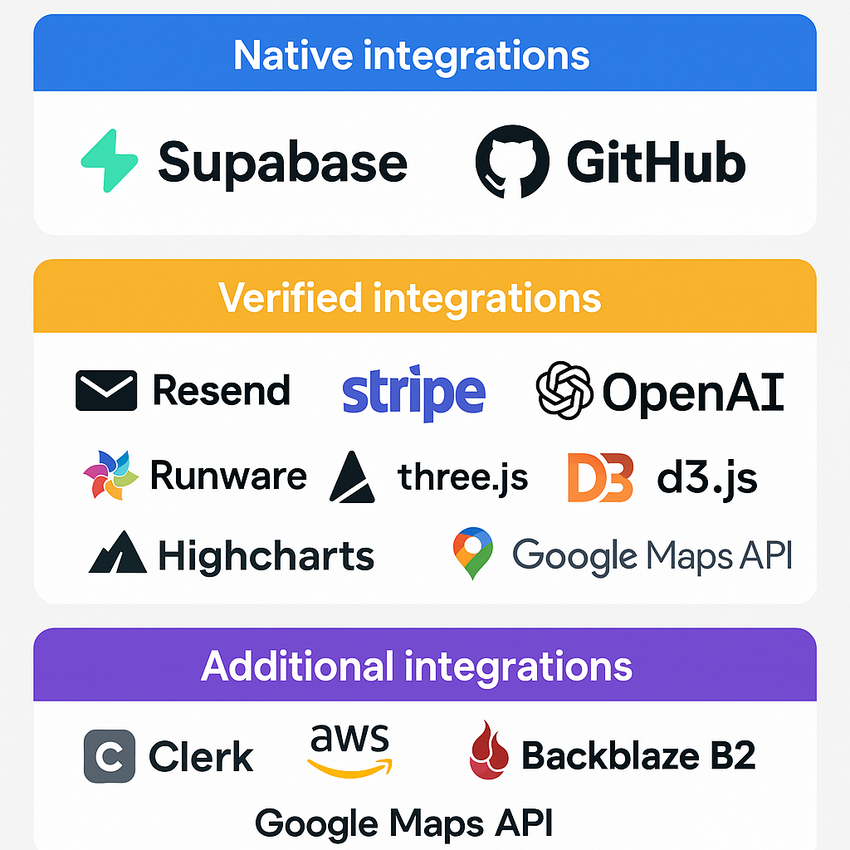Lovable most requested SaaS application integrations
Modern applications leverage API integrations to extend functionality far beyond their core codebase, transforming simple apps into comprehensive business solutions. These integrations span critical business operations across authentication, communication, data management, and commerce.
Authentication and user management integrations like Google OAuth, LinkedIn, and Microsoft provide secure, passwordless login experiences while automatically populating user profiles. These eliminate authentication overhead and improve conversion rates through familiar sign-in flows.
Communication platforms including Slack, Twilio, WhatsApp, and Discord enable real-time notifications, SMS confirmations, and community engagement without building messaging infrastructure from scratch. Applications trigger these services through webhooks and API calls when specific events occur in the database or user interface.
Data and workflow automation tools like Make, Zapier, Notion, and Airtable orchestrate complex multi-step processes, sync data across platforms, and enable no-code teams to interact with custom applications. These integrations typically use webhooks for triggering actions and REST APIs for bidirectional data synchronization.
Business operations integrations with Salesforce, HubSpot, QuickBooks, and Shopify connect custom applications to existing business systems, enabling specialized interfaces while maintaining data integrity across enterprise tools. This approach lets companies build tailored experiences without migrating away from established platforms.
|
# |
Integration |
Use Case |
Use Model |
|
1 |
A professional networking platform or B2B SaaS app needs secure user authentication without managing passwords. |
Users click "Sign in with Google/LinkedIn/Microsoft" buttons that trigger OAuth flows, automatically creating user profiles in Supabase with verified email addresses and basic profile data. |
|
|
2 |
A project management tool needs to send real-time notifications when tasks are completed or deadlines approach. |
The Lovable app uses Slack webhooks to post messages to specific channels when database triggers fire, and can create slash commands that let users interact with the app directly from Slack. |
|
|
3 |
A content management system needs to sync blog posts or documentation between a public website and internal Notion workspace. |
The app uses Notion API to fetch database entries, parse properties and content blocks, then display them as formatted pages while allowing bidirectional sync for updates. |
|
|
4 |
A CRM system needs to automatically enrich lead data, send follow-up emails, and update multiple systems when a new contact is added. |
Lovable sends webhook triggers to Make scenarios that orchestrate multi-step workflows, then receives responses back to update the UI or Supabase database with enriched data. |
|
|
5 |
A no-code operations dashboard needs to display and edit data from existing Airtable bases used by non-technical teams. |
The app uses Airtable API to read records for display in custom views (kanban, calendar, gallery) and sends PATCH requests when users edit data through the Lovable interface. |
|
|
6 |
A lead generation landing page needs to automatically add new signups to multiple marketing tools and CRMs simultaneously. |
Form submissions in Lovable trigger Zapier webhooks that branch into multiple zaps, distributing data to various platforms while returning confirmation status to the user interface. |
|
|
7 |
An appointment booking system needs to send SMS confirmations and reminders to customers who book services. |
The app calls Twilio API endpoints to send programmatic SMS messages when appointments are created or modified, storing message SIDs in Supabase for delivery tracking. |
|
|
8 |
A customer support platform needs AI voice agents that can handle phone inquiries and schedule callbacks. |
Lovable triggers Vapi calls through API requests, passing context from the user's account, then receives transcripts and structured data back to log interactions in the database. |
|
|
9 |
A sales prospecting tool needs to automatically enrich company information when users enter a domain name. |
The app sends company domains to Apollo API, receives employee counts, tech stack data, and contact information, then displays enriched data in modal views or updates Supabase records. |
|
|
10 |
A real-time collaboration tool needs live cursor positions and instant updates across multiple users simultaneously. |
The app uses Firebase Realtime Database for WebSocket-based live data sync alongside Supabase for persistent storage, with Firebase handling ephemeral state like active users and live edits. |
|
|
11 |
A SaaS platform needs custom domain support where each customer gets their own branded subdomain or domain. |
Lovable exports the project to GitHub, then connects it to Vercel for deployment with edge functions, automatic SSL, and domain management through Vercel's API. |
|
|
12 |
A newsletter platform needs to automatically add new users to email marketing campaigns and track engagement. |
The app uses Mailchimp API to add contacts to audience lists when users sign up, sync user preferences with merge tags, and pull campaign analytics to display in dashboards. |
|
|
13 |
A marketing website with forms needs to capture leads directly into HubSpot CRM while tracking their behavior on the site. |
Form submissions POST to HubSpot API to create contacts and deals, while HubSpot tracking code embedded in the app monitors page views and interactions for lead scoring. |
|
|
14 |
An enterprise sales dashboard needs to display pipeline data and allow reps to update opportunities without leaving the custom interface. |
The app authenticates via Salesforce OAuth, queries SOQL for opportunity and account data, displays it in custom visualizations, and uses REST API to update records when users take actions. |
|
|
15 |
A freelancer invoicing platform needs to automatically sync invoices, track payments, and reconcile transactions. |
The app creates invoices through QuickBooks API when users generate them, polls for payment status updates, and displays financial summaries by pulling reports through the accounting API. |
|
|
16 |
A document collaboration tool needs to let users attach Google Drive files and schedule meetings via Google Calendar. |
The app uses Google Drive Picker API for file selection, stores file IDs in Supabase, uses Google Calendar API to create events, and syncs meeting data bidirectionally. |
|
|
17 |
An enterprise document management system needs to access company files stored in SharePoint while adding custom workflows. |
The app authenticates via Microsoft Graph API, displays SharePoint document libraries in custom interfaces, implements search across files, and triggers workflows when documents are uploaded. |
|
|
18 |
A custom storefront or inventory management system needs to display products with real-time stock levels and process orders. |
The app uses Shopify Admin API to fetch products and variants, displays them in custom layouts, processes checkouts through Shopify, and receives webhooks when inventory or orders change. |
|
|
19 |
A gaming community platform needs to verify Discord membership and send automated announcements to specific servers. |
The app uses Discord OAuth to verify server membership, displays user roles, sends messages through Discord webhooks or bot API, and creates slash commands for in-Discord interactions. |
|
|
20 |
A customer service platform needs to send order confirmations and support messages through WhatsApp Business API. |
The app integrates WhatsApp Business API (through Twilio or Meta) to send template messages for notifications, receives incoming messages via webhooks, and displays conversations in a unified inbox. |


